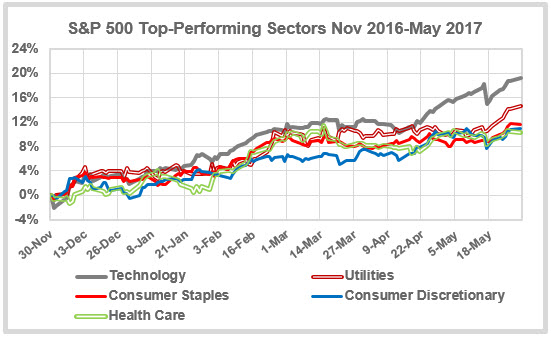Sector Analysis Suggests Investors Are Cautious About The Sustainability Of The "Trump Rally"
This article examines the sector performance of the U.S. stock market during the “Trump Rally.” Sector performance over the past six months suggests the market’s gains may not be sustainable, as market leadership has been confined mainly to sectors typically associated with a “risk-off” attitude on the part of investors.
Examining the performance of the stock market broken down by sectors can yield insights into the sustainability of the current market trend. Since November 2016, markets have been buoyed by the “Trump Rally,” in expectation of widespread deregulation and other market-friendly policies. The first chart below depicts the Russell 1000 (largest 1000 stocks in the U.S. by market capitalization) vs. the Russell 2000 (next 2000 largest stocks, representing the mid- and small-cap space). When small-cap stocks lead large cap stocks during a bull market phase it’s usually a positive indicator for the sustainability of the rally, suggesting that investors are comfortable taking more risk (as small-cap stocks are generally riskier). When large-cap stocks lead during a bull phase, the implication is that investors are more cautious about the sustainability of the market’s uptrend.

The graph shows that small- and large-cap stocks participated equally in the Trump rally from November through February (up 7% and 8%, respectively). From March through May, however, small-cap stocks have declined by about 2%, with large-cap stocks extending their gains by a modest 1%. Clearly, almost all the gains from the Trump rally occurred during the first 3 months following the inauguration, with the market taking more of a “wait and see” attitude since then.
The next graph below depicts the top 5 performing sectors in the S&P 500 index over the same time period (I still live in a 10 sector world, never having bought into S&P’s decision that real estate is a market sector — for me, real estate remains an asset class — sorry, S&P). Another way investors gauge the sustainability of a market rally is by which sectors are displaying the most leadership. When “risk on” sectors like Financial, Industrial, Technology, Energy, Materials and Consumer Discretionary stocks are leading the charge, it usually indicates high positive conviction on the part of investors. On the other hand, when more “risk off” sectors like Utilities, Consumer Staples and Health Care lead the way, it usually indicates dampened enthusiasm on the part of investors, who are bidding up the prices of these stocks more out of a “flight to safety” mentality.

The returns to the top-performing sectors indicates a mixed story for the current U.S. stock market. While it’s unequivocally positive to see Technology stocks in the lead (up 19% in six months), the remaining sectors among the top performers (Utilities, Consumer Staples and Health Care) are all traditionally “risk-off” sectors, suggesting caution on the part of investors. This means investors have been wading more cautiously into the Trump Rally than we typically see during a bull market phase that has long-term sustainability.

The last graph above depicts the five lowest-performing S&P 500 sectors over the past six months. Industrial stocks, a traditional risk-on sector, have led the way with an overall gain of 8%. Other typical risk-on sectors comprise most of the bottom performers, including Financials, Materials and Energy stocks, which continue to extend their dismal performance from the previous two years.
In conclusion: Sector performance during the Trump rally suggests the market’s gains may not be sustainable, as market leadership has been confined mainly to sectors typically associated with a “risk-off” mentality. If the performance of risk-on sectors such as Financials, Industrials, Materials and Energy stocks were to improve suddenly, it would be a positive sign for the sustainability of the recent bull market trend.



